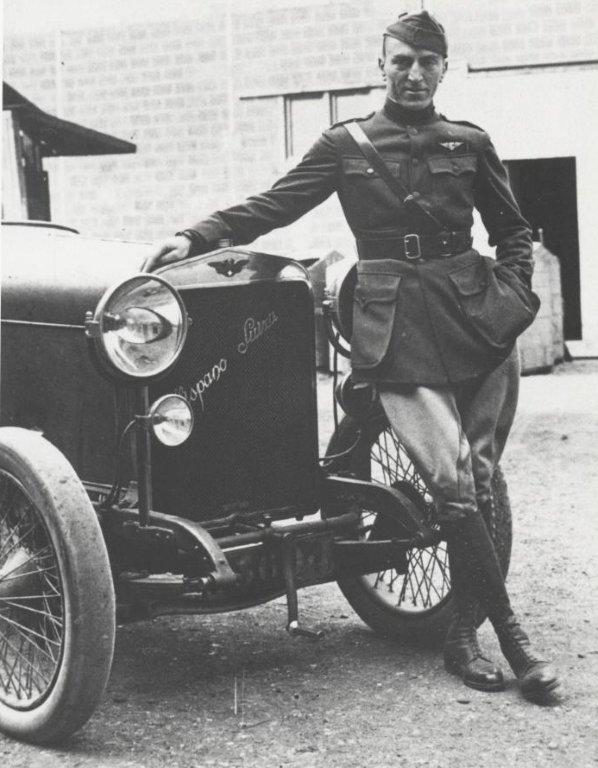

Once America entered World War I some of the first forces it sent to France were those of the newly-formed Air Service. Among those troops was a relatively famous racecar driver and mechanic who would become America’s ‘Ace of Aces’ during the war: Eddie Rickenbacker.
When Rickenbacker enlisted in the Army, he had dreams of flying but was shipped to France as a driver for the General Staff due to his experience as a racecar driver. His advanced age (27 at the time) and lack of a college degree also disqualified him for flight training – but he was undeterred.

Assigned as the driver for Col. William ‘Billy’ Mitchell, Rickenbacker took the opportunity to bother him until the Colonel finally allowed him to attend pilot training. Rickenbacker still had to claim he was only 25 though.
Related video:

Eddie completed pilot training in just 17 days and received his commission. However, Rickenbacker’s superior mechanical abilities from his days as a racecar driver sidetracked his flying career and got him assigned as the engineering officer at the Air Service Pursuit Training facility.

After finding a replacement, Rickenbacker was finally assigned to a combat flying unit – the 94th Aero Squadron – in March 1918. The squadron began flying combat missions in early April, and Rickenbacker wasted no time getting in on the action. On April 29th, Rickenbacker scored his first aerial victory and also his first Distinguished Service Cross for a vigorous fight and pursuit of a plane into enemy territory to shoot it down.
During May 1918 Lt. Rickenbacker downed five more German airplanes while earning an additional four Distinguished Service Crosses, each time attacking and dispersing larger formations of enemy planes.
Rickenbacker, through a lucky streak that seemed to last his entire life, also gained a reputation for surviving close calls and crash landings. In July 1918 in a particularly harrowing incident, “he barely made it back from one battle with a fuselage full of bullet holes, half a propeller, and a scorched streak on his helmet where an enemy bullet had nearly found its mark.”

A few days later he was grounded by an abscess in his ear but was back flying by the end of July. However, with his last kill at the end of May he would go many months without another victory.
Then on September 14, Rickenbacker started a remarkable streak, claiming his seventh kill and sixth Distinguished Service Cross. He downed another plane the next day. On September 25, he was promoted to Captain and made commander of the 94th Aero Squadron.
He promptly volunteered for a solo patrol, during which he encountered a flight of seven German planes below him. Rather than be thankful that no one saw him, he dived on the formation and attacked the shooting Germans, downed two enemy aircraft, and forced the rest to retreat. For this action, he was awarded his seventh Distinguished Service Cross.
Twelve years later, in 1930, this award was upgraded to the Medal of Honor.

At the beginning of October, Capt. Rickenbacker had 12 aerial victories. He was the leading living American pilot and was dubbed the ‘Ace of Aces’ by the press. He disliked this title because all three previous holders died in combat.
Despite his discontent with the new title, Rickenbacker led the 94th through severe fighting until the end of the war. During that time, Rickenbacker shot down ten enemy aircraft and three balloons, making him an official “balloon buster.” He also earned his eighth Distinguished Service Cross of the war – a record that hasn’t been broken.
Capt. Rickenbacker ended World War I with a total of 26 aerial victories to his credit, the American ‘Ace of Aces’ for World War I and the rank of Major. The Army promoted Rickenbacker as he left active duty but he never claimed the promotion. He felt his “rank of Captain was earned and deserved.” The public referred to him to as “Captain Eddie” for the rest of his life.

After the war, Rickenbacker went into many ventures in the automobile and aviation industries and survived many more brushes with death. He survived a near-fatal crash in early 1941 that had him out of action for almost a year. During World War II, while on a personal mission to deliver a message to Gen. MacArthur from President Roosevelt and to inspect American aviation facilities in the Pacific, the plane he was flying in lost its way and was forced to ditch in the Pacific Ocean.
Rickenbacker and the surviving crew members endured over three weeks of life rafts before rescue. Consistent with his dogged determination Rickenbacker completed his assignment before returning to the states, despite losing 60 pounds and suffering from severe sunburn.

Rickenbacker, without formal education past age 12, would eventually rise to control his own airline, Eastern Air Lines, and make it the only self-sufficient, free-enterprise – he accepted no government subsidies – airline in America for many years. He was also the majority owner of Indianapolis Motor Speedway for many years during which time he significantly improved the track.
Captain Eddie retired in 1963. In 1972 he suffered a stroke, his last near-death experience. He recovered from the stroke but while visiting Switzerland he contracted pneumonia, and his luck finally ran out. He passed away July 23, 1973, at the age of 82 – a renowned fighter pilot and successful businessman.
